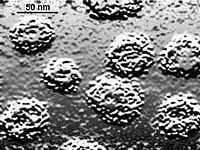- Papillomavirus
-
Papillomavirus
?Papillomavirus
HPV al microscopio electrónico de barrido.Clasificación de los virus Grupo: I (Virus ADN bicatenario) Familia: Papovaviridae Género: Papillomavirus Los virus del género Papillomavirus, entre los que se incluyen, entre otros, los «virus del papiloma humano» o «HPV» (por sus inciales en inglés human papilloma virus), son un grupo diverso de virus ADN que infectan la piel y membranas mucosas de humanos y de variedad de animales. Miembros de la (sub)familia Papillomaviridae (Papovaviridae según otros autores),[1] su especie tipo es el virus del papiloma del conejo de cola de algodon (o CRPV, del inglés cottontail rabbit papillomavirus)[2] Todos sus representantes afectan a vertebrados.
La naturaleza de su genoma los hace clasificarse en la clase I de Baltimore. Es decir, se trata de virus cuyo material genético es ADN de doble cadena, replicado por la maquinaria celular en ausencia de retrotranscriptasas. De hecho, su replicación depende incluso del tipo celular, que sólo ocurre en queratinocitos diferenciados de la piel u otras mucosas,[3] si bien producen varias clases de reguladoras trans para facilitar la consecución de su ciclo vital. Carecen de envoltura viral.[1]
Referencias
- ↑ a b Cann, Alan J. (2005). Principles of Molecular Virology, 4 edición, Burlington, USA: Elsevier. ISBN 0-12-088787-8.
- ↑ Christensen ND (2005). «Cottontail rabbit papillomavirus (CRPV) model system to test antiviral and immunotherapeutic strategies» Antivir. Chem. Chemother.. Vol. 16. n.º 6. pp. 355–62. PMID 16331841.
- ↑ Doorbar J (2005). «The papillomavirus life cycle» J. Clin. Virol.. Vol. 32 Suppl 1. pp. S7–15. DOI 10.1016/j.jcv.2004.12.006. PMID 15753007.
Véase también
Categoría: Papovaviridae
Wikimedia foundation. 2010.
